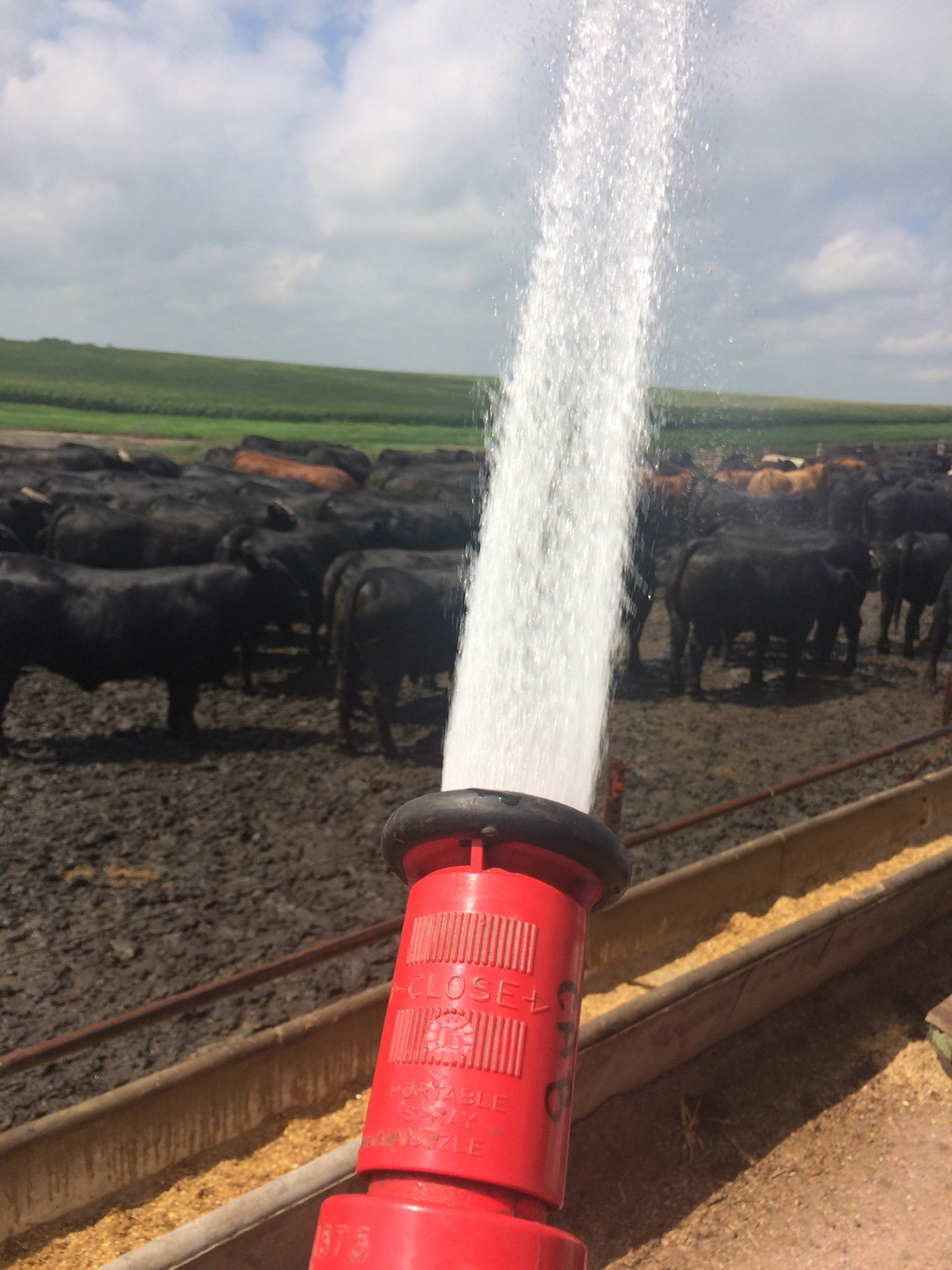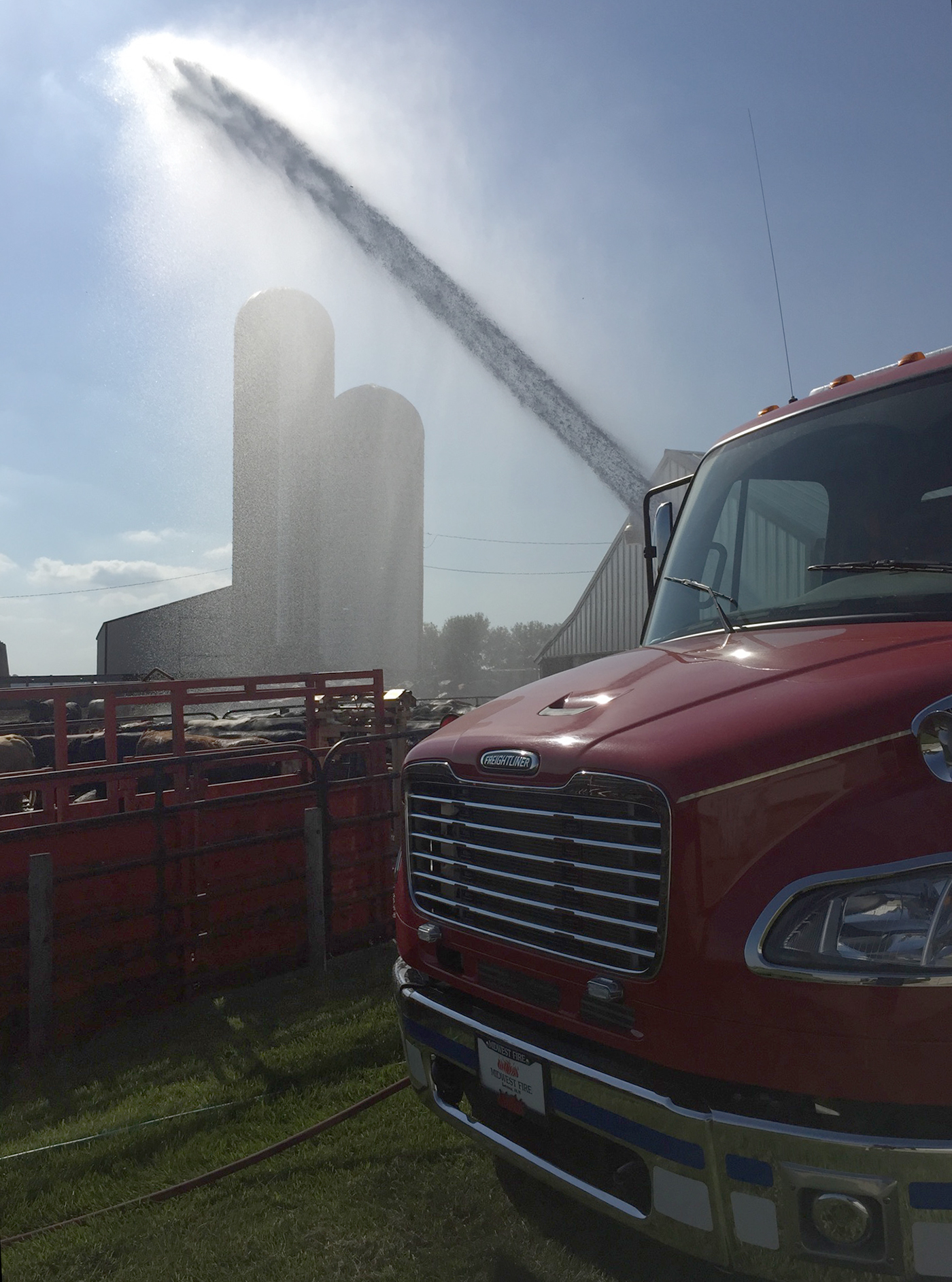 ,
, 
Hundreds of cattle perished last week in and around Rock County after four days of scorching temperatures and oppressive humidity.
Rendering trucks logged extra miles to keep up with mounting losses, according to Alan Klarenbeek. “We’ve got all four trucks running today,” he said Friday. “And we’ll run them all tomorrow, too.”
He said killing heat waves are rare, but in more than 20 years of business he’s seen tough times in cattle yards.
“I remember one year (2011) they had to close the plant because there were too many,” he said. “We couldn’t pick up at the farms, and those had to be buried.”
Lethal conditions
According to Luverne volunteer weather recorder Troy Thone, last week’s temperature spike wasn’t a record-breaker, but the combination of heat and humidity — known as the heat index — was lethal.
The high on July 20 was 88 with a heat index of 100 degrees. On July 21 and 22 air temperatures reached 90 degrees with a heat index of 102. July 23 saw a high of 88 with a heat index of 100.
Thone’s records show a dew point of 77 degrees all four days.
“We were nowhere near reaching the record high temperatures,” he said.
“But any heat index temperature in the 100-degree range is extremely dangerous for anyone outside.”
The real killer for livestock during this time was that there was no relief overnight.
According to Dr. Erin de Koning of Rock Veterinary Clinic, cattle don't perspire, and if they don't have access to adequate water and shade, prolonged heat exposure can be deadly.
“A hot day or two they can handle,” she said Friday, “but so many days in a row when the temperatures don't drop down overnight … and then you get a day like (Friday) with no wind …”
She said producers have been working hard to save their livestock. “They're sprinkling them,” she said Friday. “Some are welding the holes shut in the bottoms of cattle feeders and filling them with water.”
Life-saving water
Luverne cattleman Mike Feikema said watering his cattle yards became a full-time job for three days in a row.
“I was very fortunate,” he said. “We started hosing cattle down Thursday morning and continued through Saturday … I would guess we went through 20,000 gallons of water per day.”
He said the goal was to cool off the surface of the pens, but the cattle themselves enjoyed the water.
“I’ve never seen cattle running toward the water like that,” he said. “They’d follow you through the whole pen.”
The problem for some with private wells is that pumps don't always keep up with demand, and an equipment malfunction could become a major disaster.
For example, swine operations can withstand a heat wave, but they depend heavily on mechanics.
“You have to keep the fans running,” de Koning said, noting a couple of instances this summer when 600 and 800 head of swine were lost due to equipment failure. “And even then, you still have to babysit.”
Firemen were also popular among livestock producers. “If you know someone in the fire department, one of our clients had the fire department come out and spray the cattle yards,” de Koning said.
Luverne Fire Chief David Van Batavia said it's true that the fire equipment has been used to help save cattle.
“We don't treat it like a regular fire call where we send out the page,” he said, “but we coordinate among ourselves to help someone out.”
Hardwick and Hills fire departments also reportedly assisted farmers in their areas.
Keeping up with demand
According to Rock County Rural Water Director Brent Hoffmann, a heat wave can prompt heavy spikes in water use among livestock producers on the pipeline.
“It is always higher this time of year when it's hot,” he said Friday. “Basically double what we do in the winter.”
Summer average use (especially when farmers are mixing spray for their fields) is nearly 900,000 gallons per day compared with roughly 600,000 in the winter.
But during last week’s heat wave, water use spiked to more than 1.2 million gallons per day.
He added that the rural system is designed to handle these peak demands.
“Our plant is designed for up to 2 million gallons per day, plus we can offset some of that with Lewis and Clark water,” Hoffmann said.
In cases where farmers couldn’t get enough pressure from their Rural Water connection, Hoffmann said it’s because their service lines weren’t designed for that kind of demand. “Their lines were built for what was there at the time,” he said.
Rock County is home to more than 300 commercial cattle operations with another 150 that are considered smaller operations.
Not all of these are rural water customers, but Hoffmann said more than three quarters of Rock County Rural Water is used for livestock purposes.
“That’s why we did this big expansion,” he said referring to Rural Water’s northwest expansion project. “We’re trying to keep the pressure as good as we can for as long as we can.”
Comfort in numbers
Feikema’s water efforts paid off; he lost only two animals.
Others in the county reported losses of 50 or more.
Many of those producers are friends and colleagues of Feikema, who said cattle producers often lean on each other in a crisis.
“This ranks up there with one of the worst heat waves I can remember,” he said. “You don’t necessarily plan for these things. … But cattle feeders are a really resourceful bunch.”
He said they shared ideas about what works and what doesn’t and how to improve methods for the next heat wave.
Beaver Creek cattle producer Peter Bakken said this network of support helps in more ways than one.
“It really takes a mental toll,” he said. “There’s just nothing like watching something die because it’s too hot.”
Peter and his brother, Jay Bakken, own Blac-X Farms, which lost more than a dozen cattle to last week’s heat.
“Mother Nature always wins,” Peter said. “I think we managed really well, considering.”
Economic loss
For livestock producers already operating in a depressed cattle market, the heat losses are a tough economic hardship.
Finished cattle are currently worth about $1 per pound, and the heavier cattle are most vulnerable to the heat. So, many producers are seeing their 1,000- to 1,500-pound animals perish, totaling $1,000 to $1,500 in losses for each one.
And Minnesota is one of the few states in the nation where heat insurance isn’t available. Farmers can insure against blizzard losses, but not for heat.
Rock County FSA Director Fraser Norton has been fielding calls from cattle producers about tools available to lessen the blow.
“The Livestock Indemnity Program (LIP) will provide benefits for livestock deaths in excess of normal mortality caused by adverse weather, such as last week’s extreme heat event,” Norton said.
“The normal mortality rate for cattle 800 pounds or more is 1.5 percent; thereafter LIP will pay 75 percent of the fair market value of the livestock on the day before the date of death, which in the case of beef cattle 800 pounds or more is $1,120.38 per head.”
He said nearly 200 cattle succumbed to last week’s deadly heat wave, and it was worse in neighboring counties in Iowa.
Norton said a notice of loss must be filed at his office within 30 days of livestock loss.
In addition, an application for payment must be filed no later than 90 calendar days after the end of the calendar year in which the weather event occurred.
When an application is submitted, verifiable evidence must be provided identifying the name of the producer, the date, the quantity, the kind/type and weight range of the livestock.
“Rendering truck receipts that contain this information are by far the best form of verifiable evidence,” Norton said.
‘Take care of humans first’
De Koning said she fields plenty of questions about caring for animals in the heat, but she said too often people forget the obvious.
“Take care of the humans first,” she said. “It's dangerous. I talked to a few people yesterday who got too much heat. You've got to take care of yourself first.”
According to Dr. Zach Nolz at Sanford Luverne, the local emergency room had its share of heat-related cases.
“We had a few where they had been working outside and came in just not feeling right,” Nolz said.
In most cases, these patients were fine after fluids and rest, but Nolz said it’s important to take the heat seriously and stay hydrated and out of direct sun.
“The most important thing is cooling down,” he said about those who think they might have heat exhaustion. “Drink fluids and find shade.”
He said those who become confused or have seizures should receive immediate medical attention.
Those with questions about heat-related symptoms can call the Sanford clinic phone number, 283-4476.


